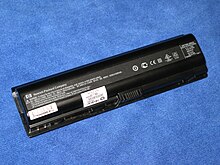This article includes a list of general references, but it lacks sufficient corresponding inline citations. (January 2015) |


A smart battery or a smart battery pack is a rechargeable battery pack with a built-in battery management system (BMS), usually designed for use in a portable computer such as a laptop.[1][2] In addition to the usual positive and negative terminals, a smart battery has two or more terminals to connect to the BMS; typically the negative terminal is also used as BMS "ground". BMS interface examples are: SMBus, PMBus, EIA-232, EIA-485,[3] and Local Interconnect Network.
Internally, a smart battery can measure voltage and current, and deduce charge level and SoH (State of Health) parameters, indicating the state of the cells. Externally, a smart battery can communicate with a smart battery charger and a "smart energy user" via the bus interface. A smart battery can demand that the charging stop, request charging, or demand that the smart energy user stop using power from this battery. There are standard specifications for smart batteries: Smart Battery System,[3] MIPI BIF and many ad-hoc specifications.
- ^ Pradhan, S. K.; Chakraborty, B. (2022-07-01). "Battery management strategies: An essential review for battery state of health monitoring techniques". Journal of Energy Storage. 51: 104427. doi:10.1016/j.est.2022.104427. ISSN 2352-152X.
- ^ Lee, Yu-Lin; Lin, Chang-Hua; Pai, Kai-Jun; Lin, Yu-Liang (2022-09-01). "Modular design and validation for battery management systems based on dual-concentration architectures". Journal of Energy Storage. 53: 105068. doi:10.1016/j.est.2022.105068. ISSN 2352-152X.
- ^ a b "MIPI BIF (Battery Interface) for mobile devices". mipi.org.